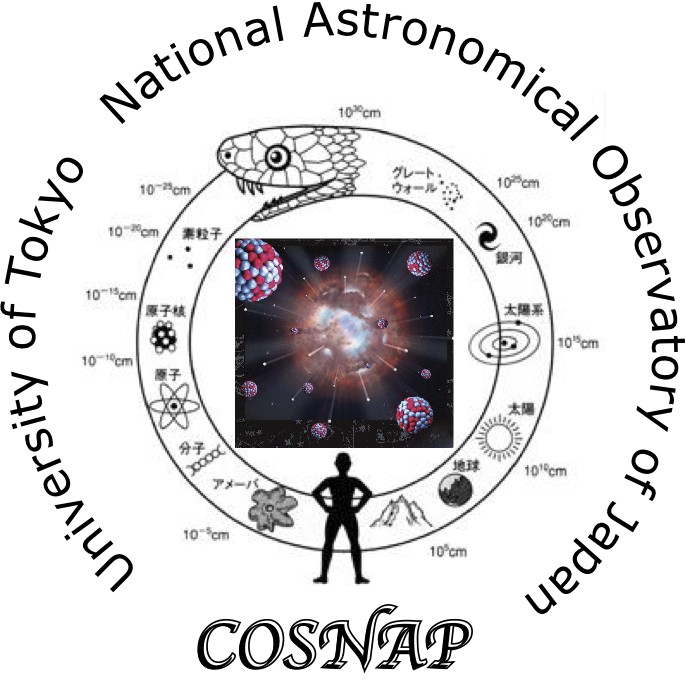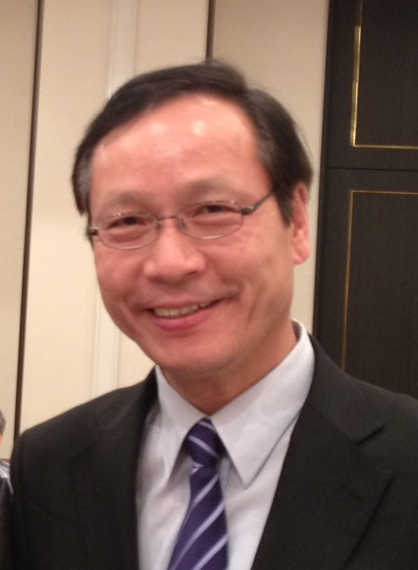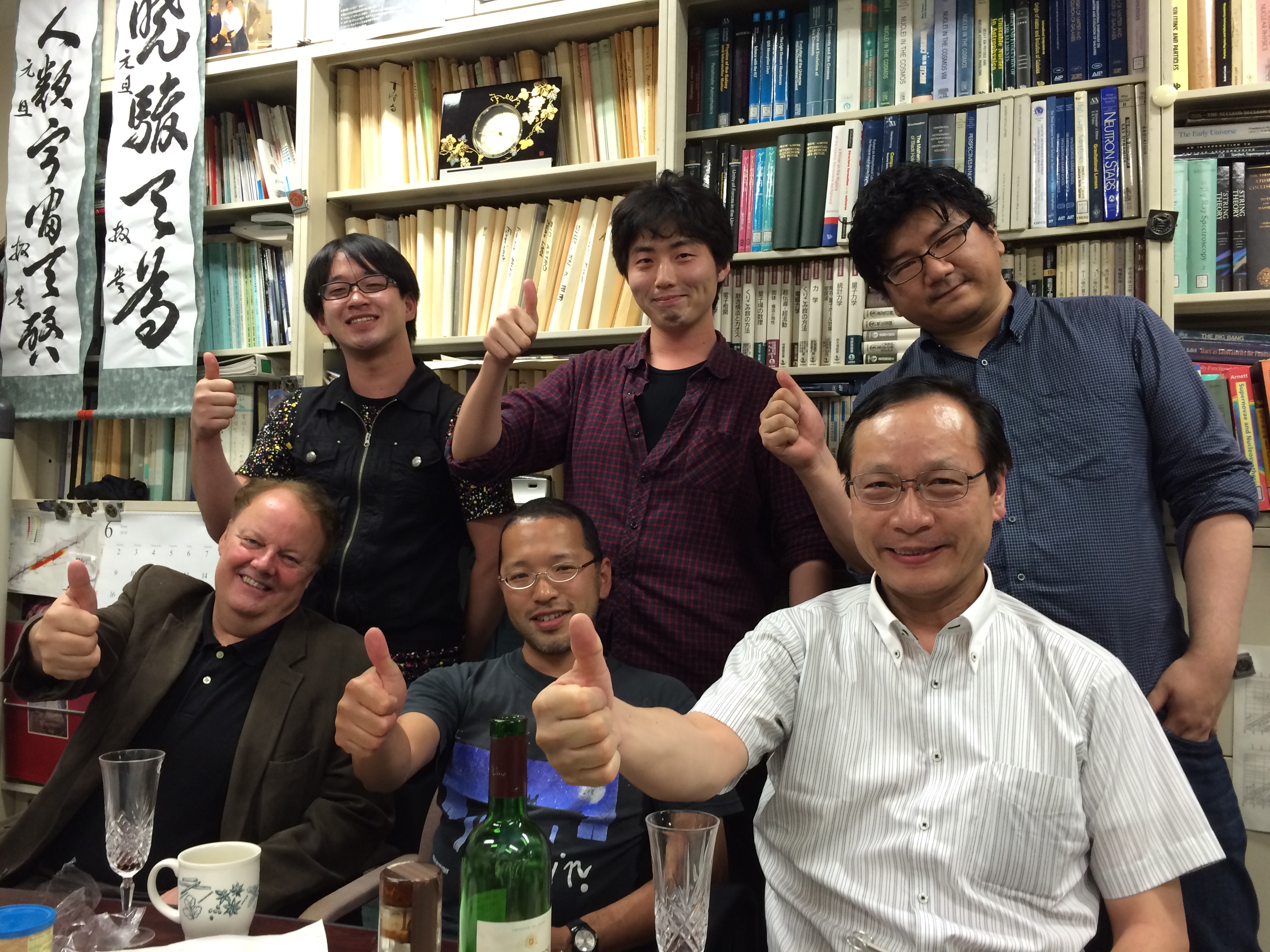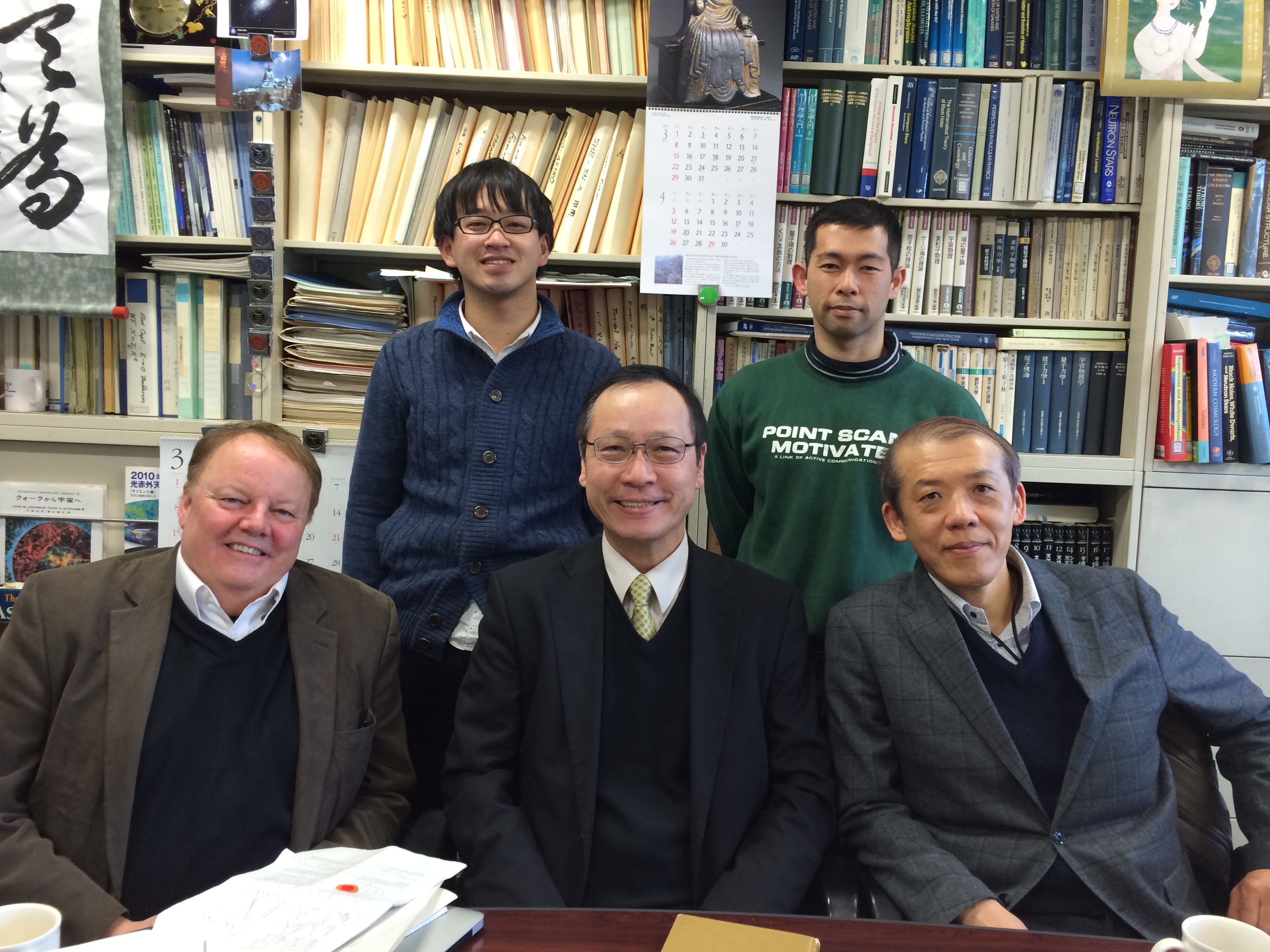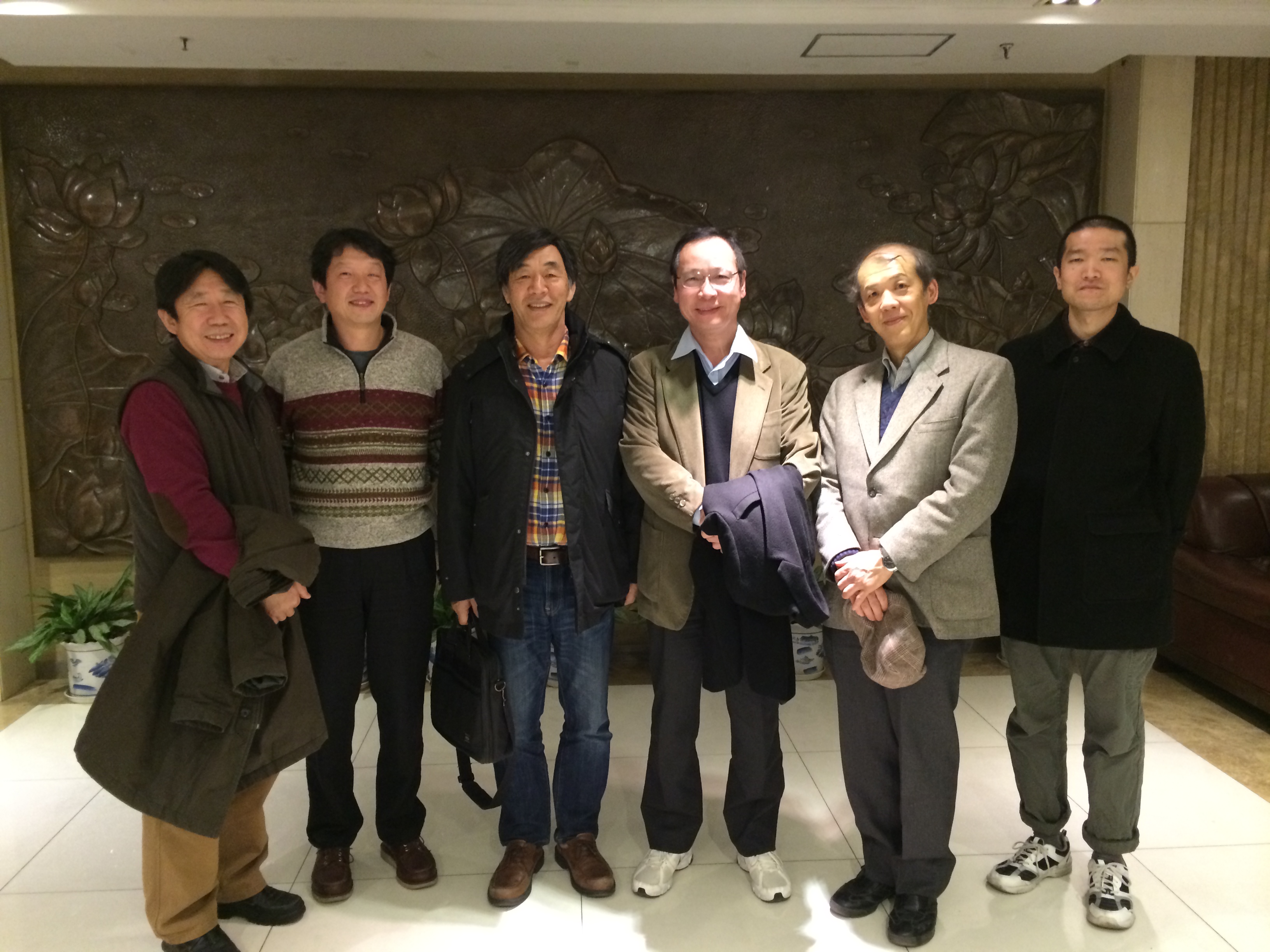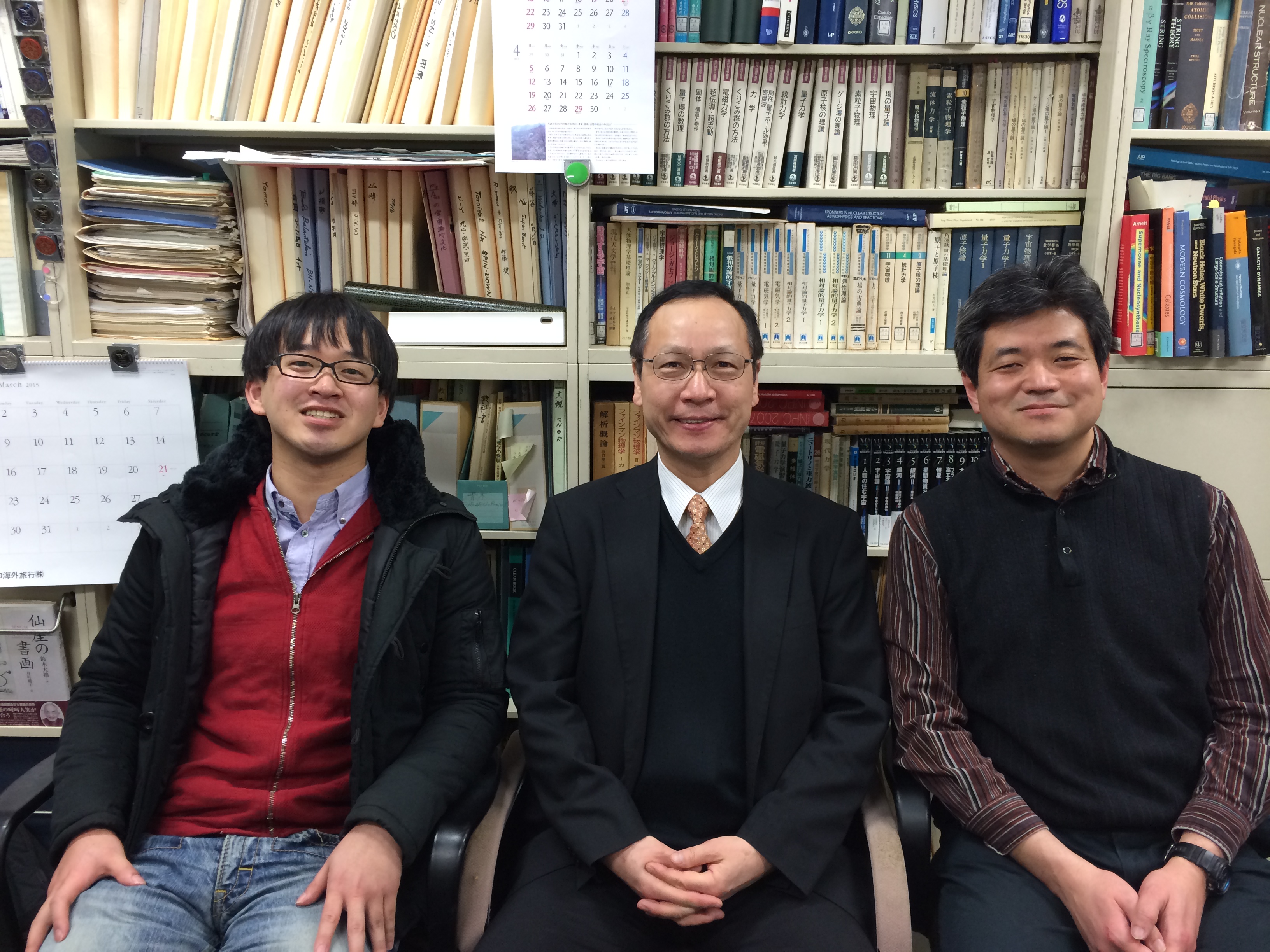| TOP | |
|
|
|
| News | |
|
|
|
| |
Research Highlights |
|
|
|
| International Meetings, Research & Teaching Activity | |
|
|
|
| CV | |
| Welcome to COSNAP website ! | ||
|
||
|
||
| |
||
| |
||
| ----------------------------------------------------------------------------------------------------------- | ||
| COSNAP is a Theory Group on | ||
| “COSmology and Nuclear AstroPhysics” | ||
| in National Astronomical Observatory of Japan, The University of Tokyo, and | ||
| International Research Center for Big-Bang Cosmology and Element Genesis (IRCBBC), Beihang University. | ||
| Contact address: National Astronomical Observatory of Japan, 2-21-1 Osawa, Mitaka, Tokyo 181-8588, Japan Phone: +81 422 34 3740, Fax: +81 422 34 3746, E-mail: kajino_@_nao.ac.jp HP: http://th.nao.ac.jp/MEMBER/kajino/e/ Beihang University (Beijing University of Aeronautics and Astronautics; BUAA), Beijing 100083, P.R. China Phone: +86 15201573880, E-mail: kajino_@_buaa.edu.cn |
||
| ----------------------------------------------------------------------------------------------------------- | ||
| |
||
| |
||
|
COSNAP
group is directed by Prof. T. Kajino (NAOJ & University of
Tokyo) and several regular members.
They are Prof. Wako Aoki (NAOJ), Prof. Tomoya Takiwaki (NAOJ), Dr. Hajime Sotani (RIKEN), Dr. Takuma Suda (Tokyo University of Technology), Dr. Hirokazu Sasaki (Los Alamos National Laboratory), Dr. Kanji Mori (NAOJ), Dr. Yudong Luo (Peking University), and Mr. Yuta Yamazaki (D3, University of Tokyo). Prof. T. Kajino is also the director of IRCBBC at Beihang University, and Prof. M. Kusakabe (Beihang University), Dr. Jun Hidaka (Meisei University & NAOJ & Beihang University), Dr. Masahiko Katsuma (Osaka City University & Beihang University), Mr. Xingqun Yao (D3, Beihang University), Mr. Zhenyu He (D2, Beihang University), and several faculty members and visiting professors are the active members at COSNAP group in Beijing. Prof. I. Tanihata, Prof. L.S. Geng, Prof. S.S. Zhang, Prof. B.H. Sun, Prof. H. Watanabe, Prof. S. Terashima at Beihang University and several International Associates also are the active members of COSNAP@Beijing (See below).  From left: Xingqun Yao (姚 星群, NAOJ/BUAA), and Kanji Mori (NAOJ) Dr. Kanji Mori, who used to be a graduate student of University of Tokyo and spent five years at NAOJ Mitaka and also spent years as a postdoctoral fellow at Fukuoka University, has returned to NAOJ as a JSPS Fellow. Mr. Xingqun Yao, who is Prof. Kajino's graduate student at BUAA and visited NAOJ several times in the past, has started one year stay as an intern at NAOJ, being supported by China Scholarship Council. 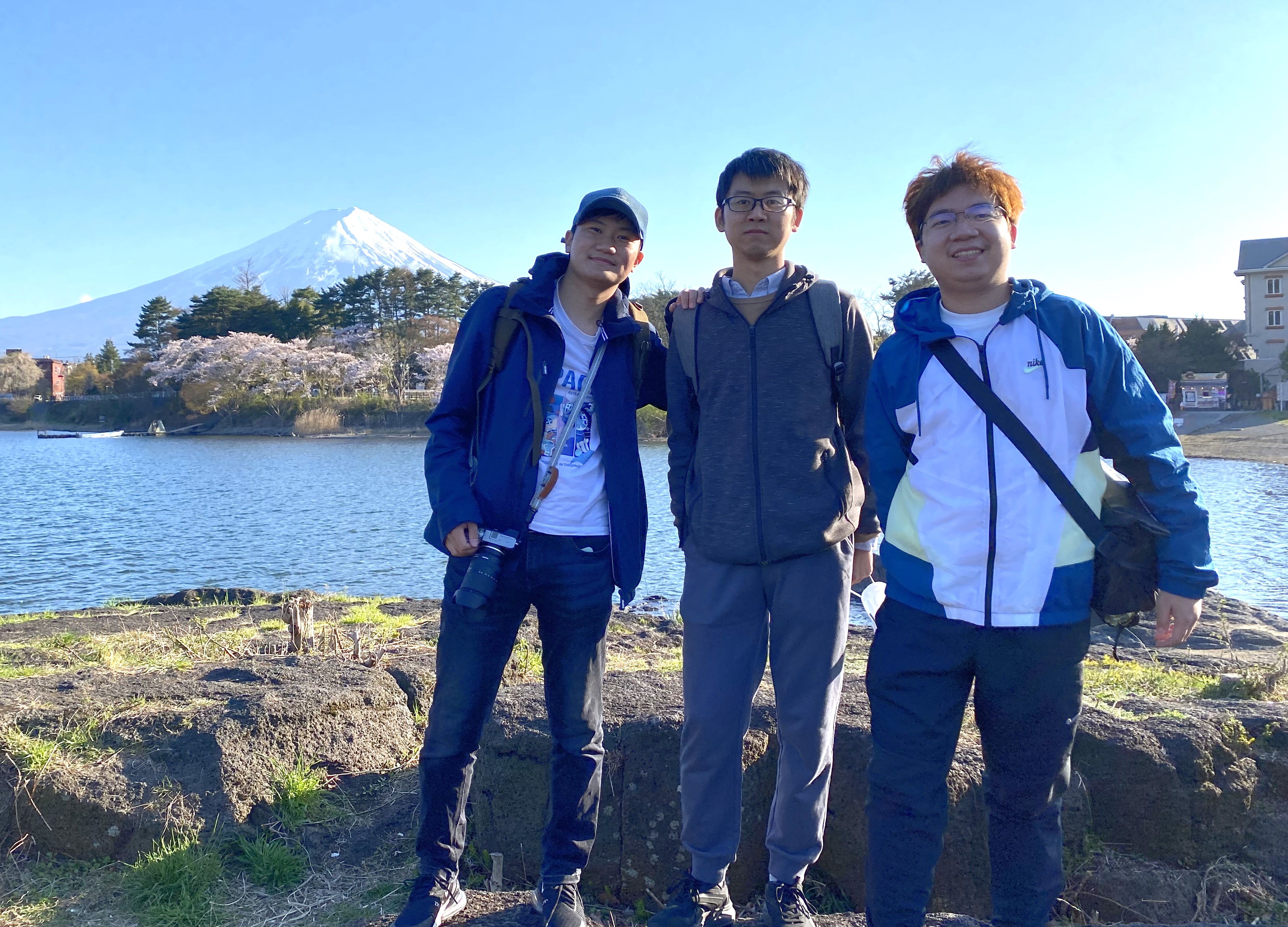 From left: Minglong Li (李 铭龙, UT), Xingqun Yao (姚 星群, NAOJ/BUAA), and Zhenyu He (何 震宇, UT/BUAA) Mr. Minglong Li, who graduated from BUAA, is currently a graduate student of Prof. Haozhao Liang's group at Department of Physics, UT. Mr. Xingqun Yao, the same as above. Mr. Zhenyu He, who is Prof. Kajino's graduate student at BUAA and is currently an intern of Prof. Haozhao Liang's group, has started one year stay at UT, being supported by China Scholarship Council.  1st line; Prof. Toshio Suzuki (Nihon University & NAOJ), Prof. Taka Kajino (NAOJ & The University of Tokyo & Beihang University), Prof. Tomoyuki Maruyama (Nihon University & NAOJ) 2nd line; Mr. Yuta Yamazaki (The University of Tokyo & NAOJ), Mr. Hirokazu Sasaki (The University of Tokyo & NAOJ), Dr. Jun Hidaka (Meisei University & NAOJ & Beihang University), Mr. Yudong Luo (The University of Tokyo & NAOJ), Mr. Kanji Mori (The University of Tokyo & NAOJ) 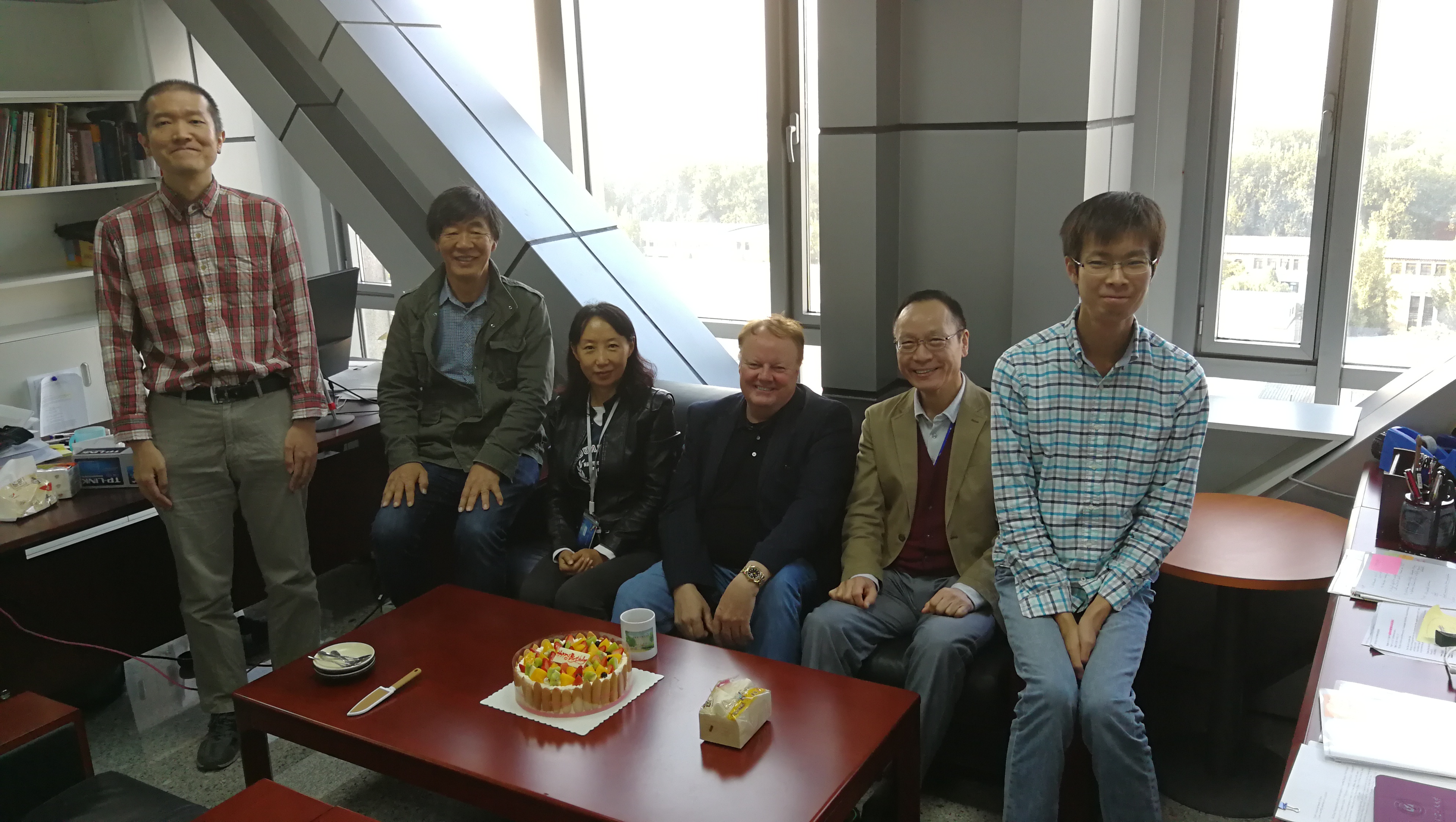 From left to right: Prof. Motohiko Kusakabe (Beihang University & NAOJ), Prof. Isao Tanihata (Beihang University & Osaka University), Ms. Shuyang Fu (Secretary of IRCBBC, Beihang University), Prof. Grant J. Mathews (University of Notre Dame & Beihang University), Prof. Taka Kajino (NAOJ & The University of Tokyo & Beihang University), Mr. Kanji Mori (The University of Tokyo & NAOJ & Beihang University) |
||
|
Research
Topics:
Our research topics include the following various
subjects: big-bang cosmology, cosmic phase transition and the creation
of
particles and nuclei, origin of dark matter and dark energy, their
roles in cosmic
structure formation and the CMB anisotropies, explosion mechanism of
supernovae
and gamma-ray bursts and nucleosynthesis of heavy elements, neutrino
astrophysics and cosmology, etc. Active national and international
collaborations are carried on among interdisciplinary sciences of
astronomy, astrophysics, cosmology, particle and nuclear physics,
meteoritic
science, plasma physics, and many others both theoretically,
observationally and
experimentally. See “Research” for more details.
|
||
【Congratulations
! 】 Yuta Yamazaki; New Doctor of
Astronomy, The University of Tokyo Mr. Yuta Yamazaki, a graduate student of our COSNAP group, has defended his Doctor thesis entitled "Galactic Chemical Evolution and Origin of Heavy Elements Synthesized Through r-process and vp-process" at Department of Astronomy, Graduate School of Science, The University of Tokyo. (March, 2023) 【Congratulations ! 】 Prize for Science and Technology awarded by MEXT to Shio Kawagoe Prof. Shio
Kawagoe (University of Tokyo), an alumnus from our COSNAP group at NAOJ
and GUAS, was
commended to the Prize for Science and Technology by the Minister of
Education, Culture, Sports, Science and Technology for her contribution
to scientific and technological outreach through popularization of
frontier researches and STEAM education. (April, 2019)
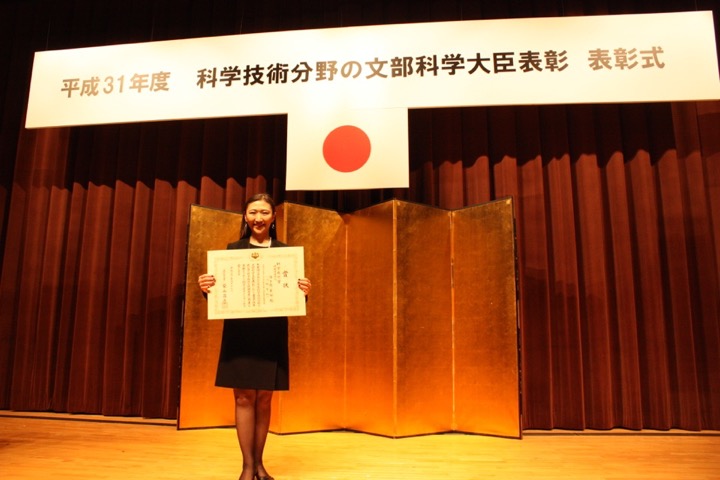 【Congratulations ! 】 BUAA Honorable Special Scholarship was awarded to Zhenyu He (何震宇) Mr.
Zhenyu He (何 震宇) who graduated from Beihang University with the top
grade and was qualified for a direct entry into graduate course in
Prof. Kajino's group without entrance exam has been awarded Honorable
Special Scholarship of this year 2019.

 Left photo: Zhenyu He, awarded BUAA
Honorable Special Scholarship 2019.
Right photo: Zhenyu He (middle), sandwiched by Prof. Motohiko Kusakabe (left) and Prof. Toshitaka Kajino (right), on graduation. 【Congratulations ! 】 JSPS Fellowship Award to Three Young COSNAP Members Mr. Hirokazu Sasaki, Mr. Kanji Mori
and Mr. Yudong Luo, who are the COSNAP members and the graduate
students of the University of Tokyo supervised by Prof. Kajino, are
awarded JSPS Fellowship from 2019 for their research projects on
"The exploration of Non-Standard Interactions in core-collapse
supernovae",
"Exploring x-ray bursts with numerical simulations, nuclear
experiments, and astronomical observations", and "Primordial magnetic
field: Its impact on big-bang nucleosynthesis and the cosmological
evolution", respectively.
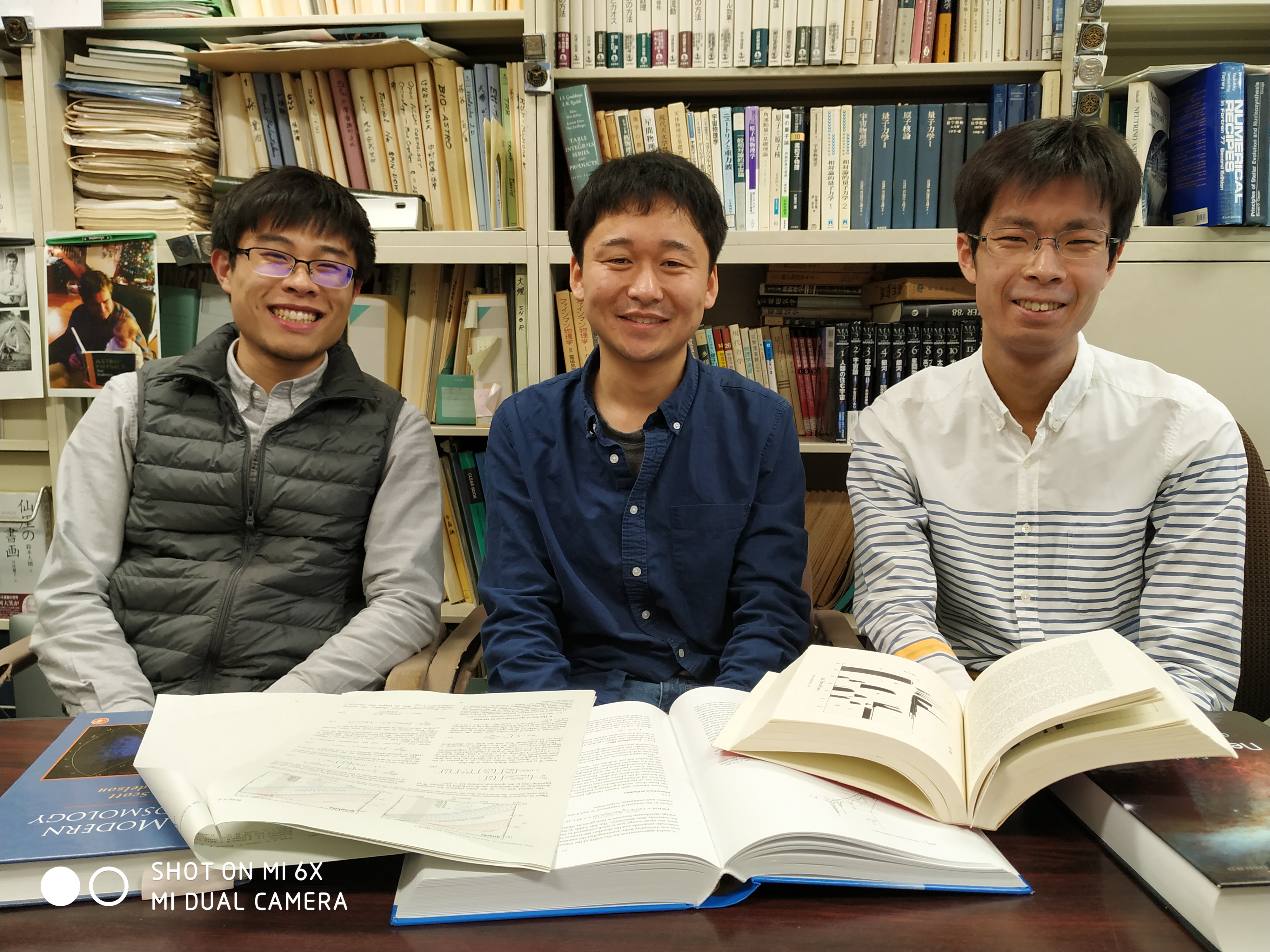 From
left to right:
Mr. Yudong Luo (D1, The University of Tokyo & NAOJ),
Mr. Hirokazu Sasaki (D3, The University of Tokyo & NAOJ), Mr. Kanji Mori (D2, The University of Tokyo & NAOJ) 【Congratulations ! 】 Best Academic Contribution Award to Toshitaka Kajino Prof. Kajino, who is the COSNAP
group leader and distinguished University professor at Beihang
University, was awarded Best Academic Contribution Award. The
University citation is “For his excellent scientific papers and
enhancing international visibility of Beihang University”.
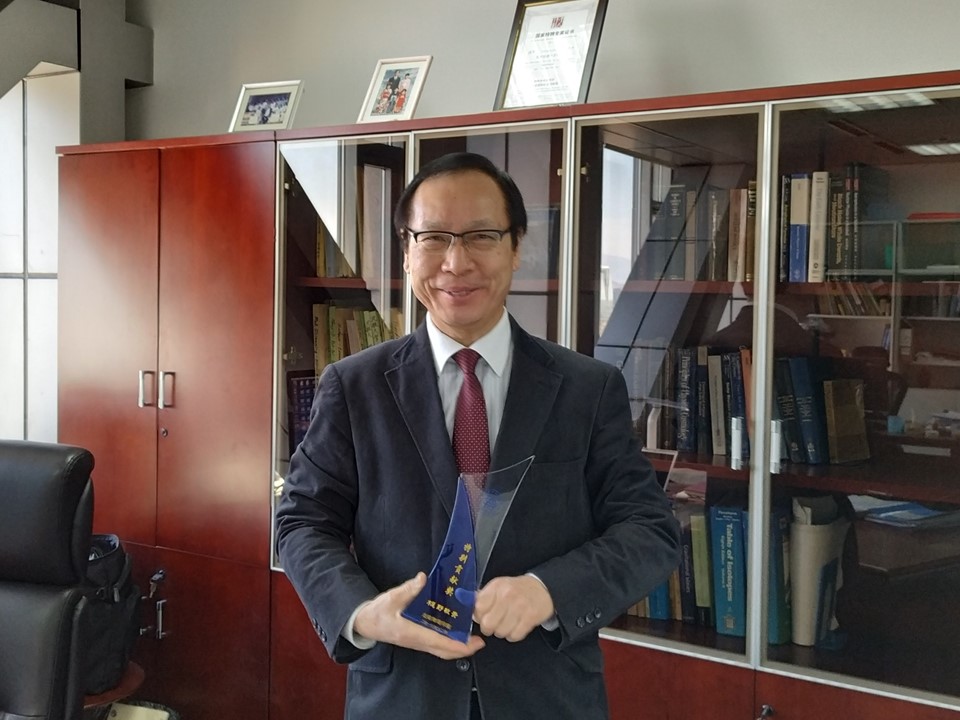 【Congratulations ! 】 Springer Theses Award to Yutaka Hirai PhD thesis of Dr. Yutaka Hirai, who graduated from the University of Tokyo in 2018 and is currently a RIKEN Research Fellow, was selected as one of the Springer Theses Awards. 【Congratulations ! 】 Promotion of Shio Kawagoe at The University of Tokyo Dr. Shio Kawagoe, an alumnus from our COSNAP group at NAOJ and GUAS, was promoted to an associate professor of Graduate School of Arts and Science, Komaba, The University of Tokyo. (September, 2018) 【Congratulations
! 】 Yudong Luo; New Master of
Astronomy, The University of Tokyo
Mr. Yudong Luo, a graduate student of our COSNAP group, has defended his Master thesis entitled "Fluctuating Cosmic Magnetic Field, Non-Maxwellian distribution, and Impact on Big-Bang Nucleosynthesis" at Department of Astronomy, Graduate School of Science, The University of Tokyo. (August, 2018) 【Congratulations ! 】 Yutaka Hirai; New Doctor of Astronomy, The University of Tokyo Mr. Yutaka Hirai, a graduate student of our COSNAP group, has defended his PhD thesis entitled "The role of enrichment of heavy elements in the chemodynamical evolution of dwarf galaxies" at Department of Astronomy, Graduate School of Science, The University of Tokyo. (March, 2018) 【Congratulations ! 】 Kanji Mori; New Master of Astronomy, The University of Tokyo Mr. Kanji Mori, a graduate student of our COSNAP group, has defended his Master thesis entitled "Quantum Mechanical Constraint on Carbon Fusion Reaction and Its Impact on Type Ia Supernovae" at Department of Astronomy, Graduate School of Science, The University of Tokyo. (March, 2018) 【Congratulations ! 】 Honor of State Special Recruited Expert Prof. Kajino, who is the COSNAP group leader and One Thousand Talents Plan Foreign Expert (April 15 in 2017), received an honor of Honorary State Special Recruited Expert of the People’s Republic of China. (January 2018) Relativistic quantum mechanical description of "photon vortices" and cosmological observation The "photon
vortex" is a special quantum state with the specific angular momentum
and coherent quantum phase in the macroscopic scale. It is thought to
be easily generated in pulsars and gamma-ray bursts surrounding
general-relativistic compact objects, i.e. neutron stars and black
holes, and affect various cosmic phenomena. In the laboratory system,
the "photon vortex" has already been generated as one of the modes of
the ultra-high brightness laser, and the wide engineering application
is expected. However, many theoretical works to clarify the nature of
"photon vortex" was limited to the study in terms of classical
electromagnetism. We have calculated, for the first time, the Compton
scattering of electrons and the most fundamental "photon vortices",
which are called Laguerre Gaussian waves, in relativistic quantum
mechanics. On the basis of this successful result, it is highly
desirable to make the next generation polarimeters capable of
distinguishing "photon vortices" from circular polarized light, if they
are equipped on the Satellite Observatory INTEGRAL-SPI or the solar
power sailor IKAROS. With this apparatus, one would be able to observe
more details of the magnetic fields and the electron energy at the
source of the "photon vortex", which opens new era in the frontier
research of magnetic field in space. (January, 2019)
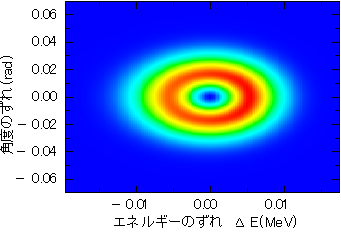 Press release: http://www.qst.go.jp/information/itemid034-005177.html Reference: T. Maruyama, T. Hayakawa, and T. Kajino, Sci. Rep. 9 (2019), 51, Compton Scattering of Gamma-ray Vortex with Laguerre Gaussian Wave Function. Can inhomogeneous primordial magnetic field solve the "Big-Bang lithium problem"? The standard
model of Big Bang
Nucleosynthesis (BBN) predicts
primordial abundances of the light elements, except for 7Li,
in
reasonable agreement with observational constraints, which is called
the "Big-Bang lithium problem" in the standard cosmology. We
investigate the effects on BBN arising from the presence of a
primordial magnetic field (PMF) whose strength is spatially
inhomogeneous as expected from the observed CMB anisotropies. If the
domains exhibit different temperatures from one another at the BBN
epoch due to the fluctuations of local energy density of the PMF, the
effective distribution function of particle velocities deviates from
the Maxwell–Boltzmann distribution when it is averaged over the
domains. Our BBN calculations by taking account of this effect of PMF
fluctuations proved to reduce significantly the primordial 7Li
abundance, thus relaxing the tension of "Big-Bang lithium
problem".
(February, 2019)
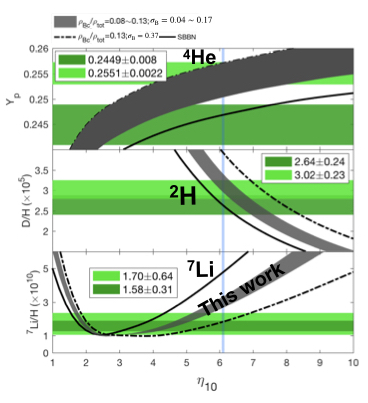 The figure shows that the
abundances of 4He, D/H, and 7Li/H
as a function of the baryon-to-photon
ratio η. The boxes show the adopted observational constraints. The gray
region shows that with inhomogeneous PMF, the 7Li
abundance can be
significant suppressed to a regime which is more consistent with the
observations.
"Big Bang Nucleosynthesis with an Inhomogeneous Primordial Magnetic Field Strength" Luo, Kajino, Kusakabe, and Mathews, 2019, ApJ, 872, 172 Type Ia
supernovae are being used as the standard candle in cosmology,
but their explosion mechanism is still unclear. They are thought to be
the explosion of carbon-oxygen white dwarfs, and their ignition is
triggered by the carbon fusion reactions. The cross sections of the
carbon fusion were poorly known and subject to large uncertainties in
the ignition condition of supernova explosions. A research group in
Italy has recently reported a new experimental result in Nature,
suggesting that the cross sections are several tens of times larger
than conventional ones due to molecular resonance. We evaluate
theoretically if the reported resonance parameters are in reasonable
agreement with quantum mechanical constraints and apply their new
enhanced cross sections to the ignition of supernovae. It is found that
white dwarf binary mergers tend to collapse to a neutron star at higher
rate than exploding as a supernova. (January, 2019)
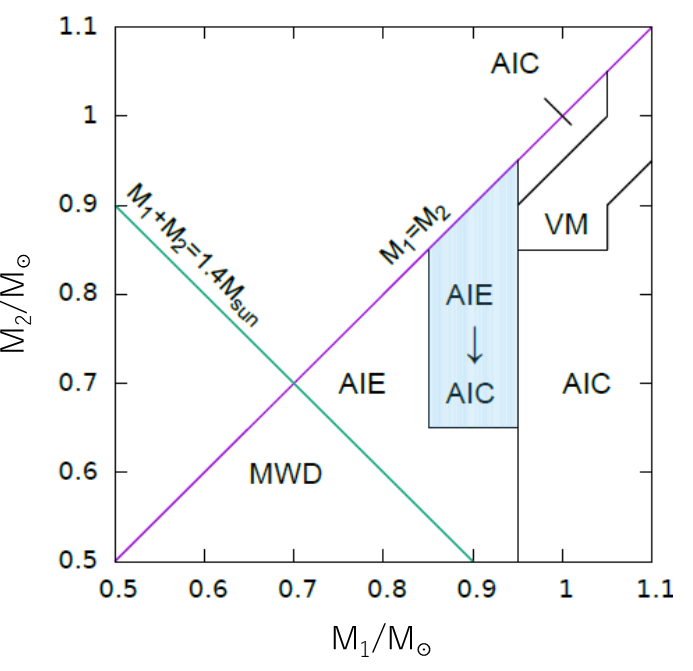 "Impacts of the new carbon fusion cross-sections on type Ia supernovae" K. Mori, M. A. Famiano, T. Kajino, M. Kusakabe and X. Tang. 2019, Monthly Notices of the Royal Astronomical Society, 482, L70. Cosmochronometer 98Tc is produced abundantly by supernova electron antineutrinos An
international collaboration including Toshitaka Kajino and Motohiko
Kusakabe (2018 NAOJ Visiting Professor) in
the COSNAP
group found that the short-lived nuclide 98Tc
is produced significantly
by reactions of electron antineutrinos with nuclei in supernovae. In
the end of massive stellar evolution, supernovae occur and an extremely
large number of neutrinos and antineutrinos are emitted from a neutron
star in the center. The collaboration group calculated nucleosynthesis
of 98Tc in supernovae taking into account
neutrino and antineutrino
reactions of preexisting nuclei. It was then shown that the
charged-current anti-neutrino reactions significantly contribute to the
production of 98Tc in supernovae. The 98Tc
is
the first nuclide whose
production was found to be sensitive to the antineutrino energy
spectrum. It is a potential chronometer for the time between the last
supernova before the solar system formation and the meteoritic
formation. Therefore, future measurements of its meteoritic abundance
can be used to deduce the antineutrino spectrum and the time scale of
the meteoritic formation. (September, 2018)
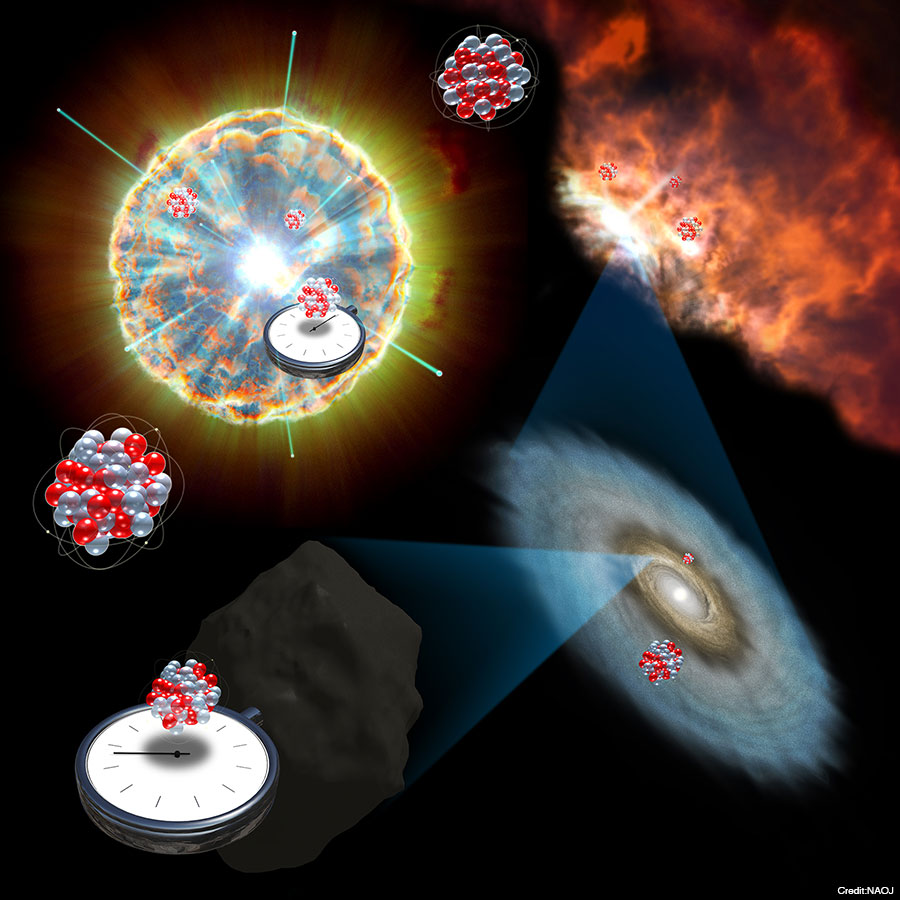 Illustration:
Cosmic clocks. We can estimate the age of heavy elements in the
primordial Solar System by measuring the traces left in meteorites by
specific radioactive nuclei synthesized in certain types of supernovae.
(Credit: NAOJ)
Details will be found in NAOJ web site: https://www.nao.ac.jp/en/news/science/2018/20180904-theory.html "Short-Lived Radioisotope 98Tc Synthesized by the Supernova Neutrino Process" Takehito Hayakawa, Heamin Ko, Myung-Ki Cheoun, Motohiko Kusakabe, Toshitaka Kajino, Mark D. Usang, Satoshi Chiba, Ko Nakamura, Alexey Tolstov, Ken’ichi Nomoto, Masa-aki Hashimoto, Masaomi Ono, Toshihiko Kawano, and Grant J. Mathews 2018, Physical Review Letters, 121, 102701. https://journals.aps.org/prl/abstract/10.1103/PhysRevLett.121.102701 Nucleosynthesis Constraints on the Explosion Mechanism for Type Ia Supernovae Type Ia
supernovae (SNe Ia) play important roles in cosmology as a standard
candle, although their progenitors and explosion mechanisms have been a
long-standing mystery. One possible solution is to compare theoretical
and observational nucleosynthetic yields, which needs careful
collaboration among theories, observations, and experiments of
astronomy and nuclear physics. Recent observations have revealed the
abundances of radioactive elements including manganese, cobalt, iron,
and nickel. We perform collaboration among researchers on supernova
theories, astronomical observations, and experimental nuclear physics
to calculate these abundances precisely. Comparison between the
observed and the calculated isotopic ratios shows the way to diagnose
explosion mechanisms of SNe Ia. In addition to that, it is pointed out
that yields of some neutron-rich nuclei are good indicators of the
density, therefore can constrain progenitors and explosion mechanisms
if they are observed.
(September, 2018)
 "Nucleosynthesis Constraints on the Explosion Mechanism for Type Ia Supernovae" K. Mori, M. A. Famiano, T. Kajino, T. Suzuki, P. Garnavich, G. J. Mathews, R. Diehl, S. -C. Leung and K. Nomoto. 2018, The Astrophysical Journal, 863, 176. Why are we all left handed? - Theory of elementary particle origin International
collaboration team among scientists at NAOJ, The University of Tokyo,
Western Michigan University and Ohio State University has come up with
a possible way in which Mother Nature selects left-handed amino acids
in space. This new theory brings together fundamental particle physics,
electromagnetism, biology, and chemistry. Molecules in magnetic fields
can interact with leptons (some of the tiniest particles in nature
which include electrons and neutrinos). Neutrino chirality is
completely broken. Because leptons can also be chiral, they interact
with amino acids differently depending on the combination of lepton
chirality and amino acid chirality. This interaction can selectively
destroy one mirror image more than the other, resulting in the
imbalance that we see in meteorites. Since Louis Pasteur studied
molecular chirality nearly 170 years ago, a question how amino acids
got to be left-handed is one of the biggest questions in science. Not
only does this discovery predict how amino acids got to be left-handed,
it also predicts how they became left-handed in space. The
ramifications for life on the earth and elsewhere in the cosmos are
significant. The latest news on this discovery was published in
Scientific Reports (a Nature journal) on Monday, June 11 at 10am GMT.
(June, 2018)
More details will be found: Amino_Acid.pdf Radio interview: http://www.tinyurl.com/y8g5cxtd "Amino Acid Chiral Selection Via Weak Interactions in Stellar Environments: Implications for the Origin of Life" Famiano M.A., Boyd, R.N, Kajino, T., Onaka, T., & Mo, Y., Scientific Reports, vol 8. (2018): www.nature.com/articles/s41598-018-27110-z "Selection of Amino Acid Chirality via Neutrino Interactions with 14N in Crossed Electric and Magnetic Fields" Famiano, M.A., Boyd, R.N., Kajino, T., & Onaka, T., Astrobiology 18, 190 (2018). 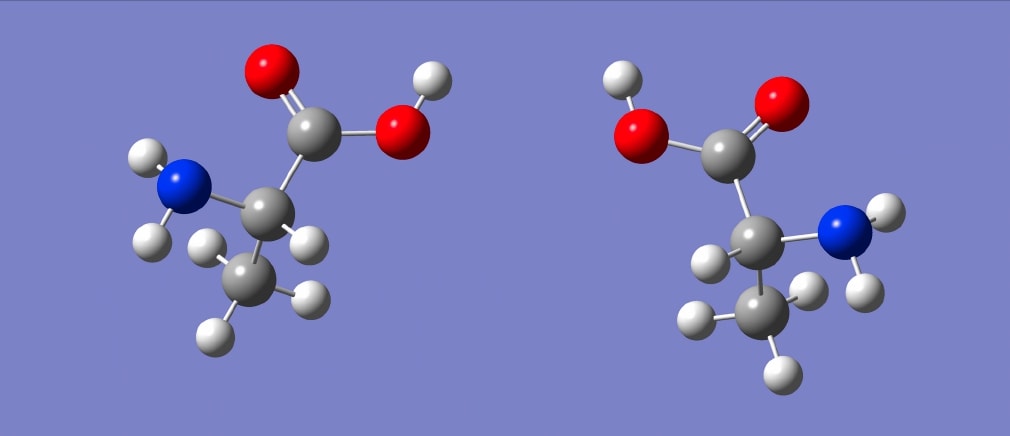 Illustration:
The amino acid alanine in its left-handed form and
right-handed form. The grey, red, blue, and white spheres are carbon,
oxygen, nitrogen, and hydrogen respectively.
Research Highlights in the past |
||
|
International Associates of COSNAP group NAOJ and BUAA Visiting Professors and Scholars visit us in Tokyo and Beijing quite often and promote collaborations;
Prof. Michael Famiano (Western Michigan University), NAOJ &
BUAA Distinguished Visiting
Professor 2018
Prof. Motohiko Kusakabe (Beihang University), NAOJ Visiting Professor 2018 Dr. Takehito Hayakawa (Nat'l Inst. Quantum and Radiological Science and Technology), NAOJ Visiting Professor 2018 Prof. Tatsushi Sjhima (Osaka University), NAOJ Visiting Professor Prof. Isao Tanihata (Osaka University & Beihang University), NAOJ Visiting Professor Prof. Myung-Ki Cheoun (Soongsil University), NAOJ & BUAA Distinguished Visiting Professor Prof. Grant J. Mathews (University of Notre Dame), NAOJ & BUAA Distinguished Visiting Professor Prof. A. Baha Balantekin (University of Wisconsin), NAOJ & BUAA Distinguished Visiting Professor Prof. Cemsinan Deliduman (Mimar Sinan Fine Arts University), NAOJ Distinguished Visiting Professor Prof. Yamac Deliduman (Mimar Sinan Fine Arts University), NAOJ Distinguished Visiting Professor Prof. Roland Diehl (MPA & Technical University of Munchen), BUAA Visiting Professor Prof. Bradley S. Meyer (Clemson University), NAOJ & BUAA Visiting Professor Prof. Jiangjun He (National Astronomical Observatory of China), BUAA Visiting Professor Prof. Wako Aoki (NAOJ), BUAA Visiting Professor Prof. Shigehiro Nagataki (RIKEN), BUAA Visiting Professor Prof. Hidetoshi Yamaguchi (CNS University of Tokyo) Prof. Dai Yamazaki (Ibaraki University) Dr. Jun Hidaka (Meisei University) Prof. Kohsuke Sumiyoshi (Numazu Nat'l College of Technology) Dr. Shunji Nishimura (RIKEN) Prof. Toshio Suzuki (Nihon University) Prof. Tomoyuki Maruyama (Nihon University) Prof. Satoshi Chiba (Tokyo Institute of Technology) (Left
photo) 1st line: Prof. Roland Diehl (MPI / BUAA), Prof. Grant J.
Mathews
(University of Notre Dame / BUAA),
Prof. Taka Kajino (NAOJ / University of Tokyo / BUAA), Prof. Michael Famiano (Western Michigan University / BUAA), Prof. Shigeru Kubono (RIKEN) 2nd line: Prof. Toshihiko Kawano (Los Alamos National Laboratory), Dr. Takehito Hayakawa (QST), Prof. Satoru Terashima (BUAA), Mr. Yudong Luo, Mr. Kanji Mori (The University of Tokyo / NAOJ), Dr. Shota Shibagaki (Fukuoka University) (Right photo) Dr. Jun Hidaka (Meisei University), Prof. Motohiko Kusakabe (BUAA), Prof. Tomoyuki Maruyama (Nihon University), Dr. Takehito Hayakawa (QST), Prof. Myung-Ki Cheoun (Soongsil University / BUAA), Mr. Hirokazu Sasaki (The University of Tokyo / NAOJ), Prof. Taka Kajino (NAOJ / University of Tokyo / BUAA), Prof. Guang-Hong Lu (Dean of Physics School, BUAA), Prof. Lisheng Geng (Deputy Dean of Physics School, BUAA) (Left
photo) Dr. Takehito Hayakawa (QST), Prof. Myung-Ki Cheoun
(Soongsil University),
Prof. Yamac Deliduman (Mimar Sinan Fine Arts University), Prof. Taka Kajino (NAOJ / University of Tokyo / Beihang University), Prof.
Tomoyuki Maruyama
(Nihon University & NAOJ)
(Right photo) 1st line; Mr. Kanji Mori (The University of Tokyo & NAOJ), Prof. Taka Kajino (NAOJ & The University of Tokyo & Beihang University), Prof. Valerio Pirronello (University of Catania), Prof. Toshio Suzuki (Nihon University & NAOJ) 2nd line; Prof. Michael A. Famiano (Western Michigan University), Prof. Baha A. Balantekin (University of Wisconsin), Prof. Silvio Cherubini (University of Catania), Prof. Kyujin Kwak (Ulsan National Institute of Science and Technology), Prof. Myung Ki Cheoun (Soongsil University) 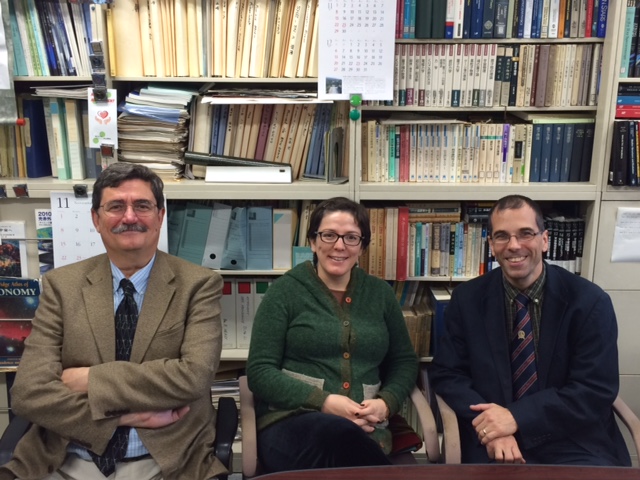
(Left photo)
Prof. A. Baha
Balantekin (University of Wisconsin),
Prof. Yamac Deliduman (Mimar Sinan Fine Arts University), Prof.
Michael Famiano (Western Michigan University)
(Right photo) Visitors from Soongsil University, Seoul in Korea Back: Dr. Ghil-Seok Yang (Soongsil University), Prof. Taka Kajino (NAOJ / University of Tokyo), Prof. Myung-Ki Cheoun (Soongsil University), Mr. Kanji Mori (University of Tokyo) Front: Dr. Eunja Ha (Soongsil University), Prof. Toshio Suzuki (Nihon University)
(Left photo) Dr. Shota Shibagaki (University of Tokyo), Mr. Akihiko Fujii (University of Calgary), Dr. Tomoya Takiwaki (NAOJ), Prof. Grant J. Mathews (University of Notre Dame), Prof. Kei'ichi Ohnaka (Catholic University of the North), Prof. Toshitaka Kajino (NAOJ / University of Tokyo) (Right photo) Prof. Grant J. Mathews (University of Notre Dame), Prof. Toshitaka Kajino (NAOJ / University of Tokyo), Prof. Tomoyuki Maruyama (Nihon University), Dr. Shota Shibagaki (University of Tokyo), Prof. Dai Yamazaki (Ibaraki University)
(Left photo / Taken at Beihang University) Prof. Myung-Ki Cheoun (Soongsil University), Dr. Shunji Nishimura (RIKEN), Prof. Isao Tanihata (Osaka University / Beihang University), Prof. Toshitaka Kajino (NAOJ / University of Tokyo), Prof. Tomoyuki Maruyama (Nihon University), Dr. Motohiko Kusakabe (University of Notre Dame) (Right photo) Dr. Shota Shibagaki (University of Tokyo), Prof. Toshitaka Kajino (NAOJ / University of Tokyo), Dr. Takehito Hayakawa (QST) 49th Summer School on Astronomy and Astrophysics in Toyohashi: Mr. Yuta
Yamazaki (M2, The University of Tokyo & NAOJ) attended
the 49th Summer School on Astronomy and Astrophysics which was held
in Toyohashi, Japan during July 30 - August 2, 2019, and made an oral
presentation. He was awarded an Oral Award in the Galaxies and Clusters
Session for his presentation.
 15th International Symposium on Origin of Matter and Evolution of Galaxies in Kyoto: Prof.
Motohiko Kusakabe (Beihang University), Mr. Kanji Mori, Mr. Yudong
Luo, Mr. Yuta Yamazaki (The University of Tokyo & NAOJ), Mr.
Xingqun Yao and Mr. Zhenyu He (Beihang University) attended
the 15th
International Symposium on Origin of Matter and Evolution of Galaxies
which was held
in Kyoto, Japan during July 2 - 5, 2019, and made oral and poster
presentations. Mr. Yudong
Luo was awarded an ANPhA (Asian Nuclear Physics Asscociation) Young
Scientist Award for his presentation.
10th European Summer School on Experimental Nuclear Astrophysics in Italy: Mr. Yudong
Luo (D1, The University of Tokyo & NAOJ) attended
the 10th European Summer School on Experimental Nuclear Astrophysics
which was held
in Catania, Italy during June 16 - 23, 2019, and made an oral
presentation on "Can Inhomogeneous Primordial Magnetic Field Affect
Nucleosynthesis in the Early Universe?". He was awarded a Best Student
Prize for his presentation
and active involvement in the school.
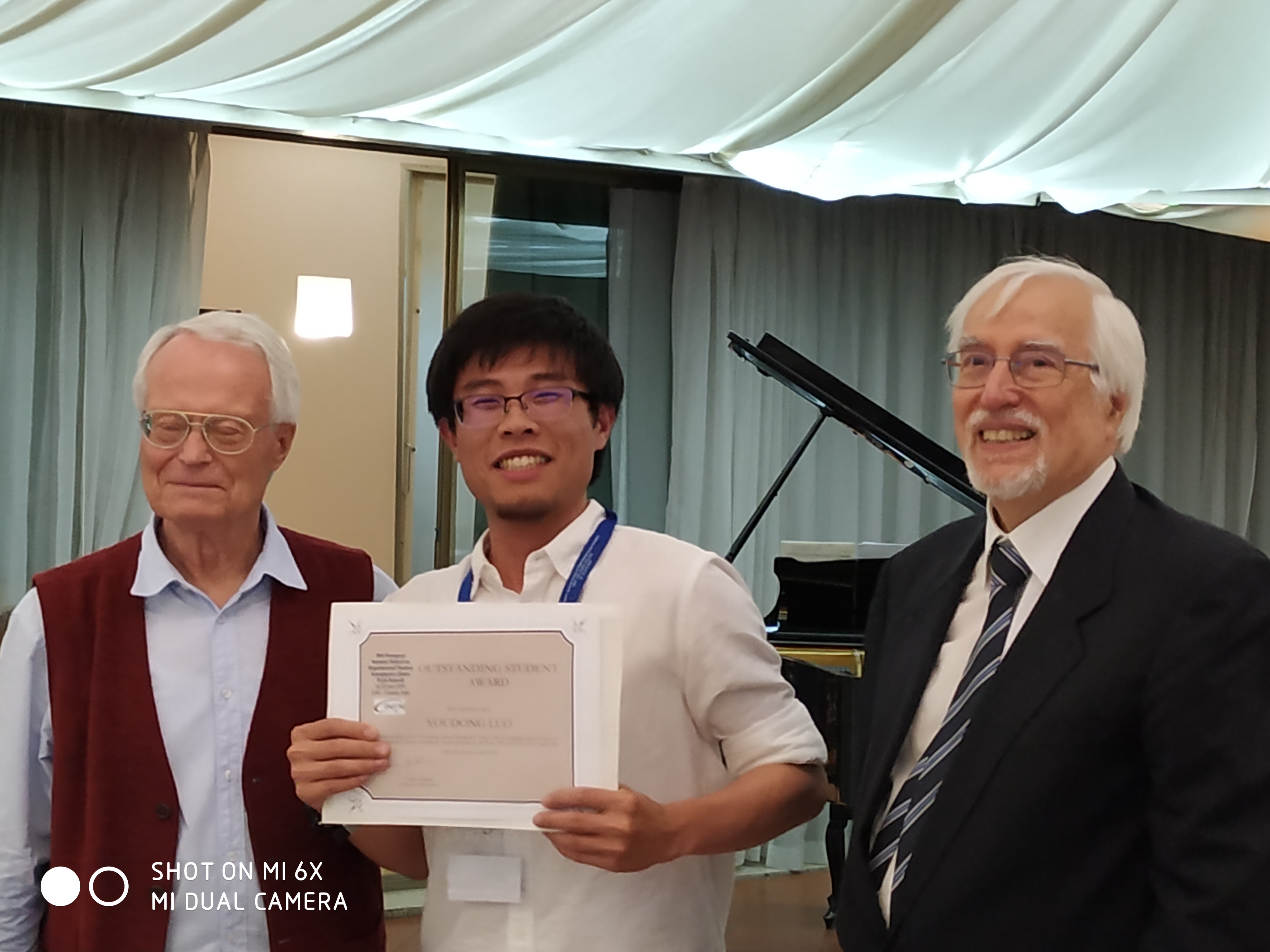 From left to right; Prof. Karl-Ludwig Kratz (the chair of the Prize Committee), Mr. Yudong Luo, and Prof. Claudio Spitaleri (the chair of the Summer School). JINA-CEE Workshop, Seminars in University Notre Dame and University of Wisconsin: Mr. Kanji
Mori (D2, The University of Tokyo & NAOJ) attended the Workshop
on JINA-CEE Frontiers in Nuclear Astrophysics which was held at
Michigan State University during May 20-24 2019. He was also invited to
University Notre Dame and University of Wisconsin and delivered seminar
talks there on "Big Bang Nucleosynthesis with Time-dependent Quark
Mass". His visit was supported by NAOJ / JINA-CEE International
Research Collaboration Program 2019 - 2020.
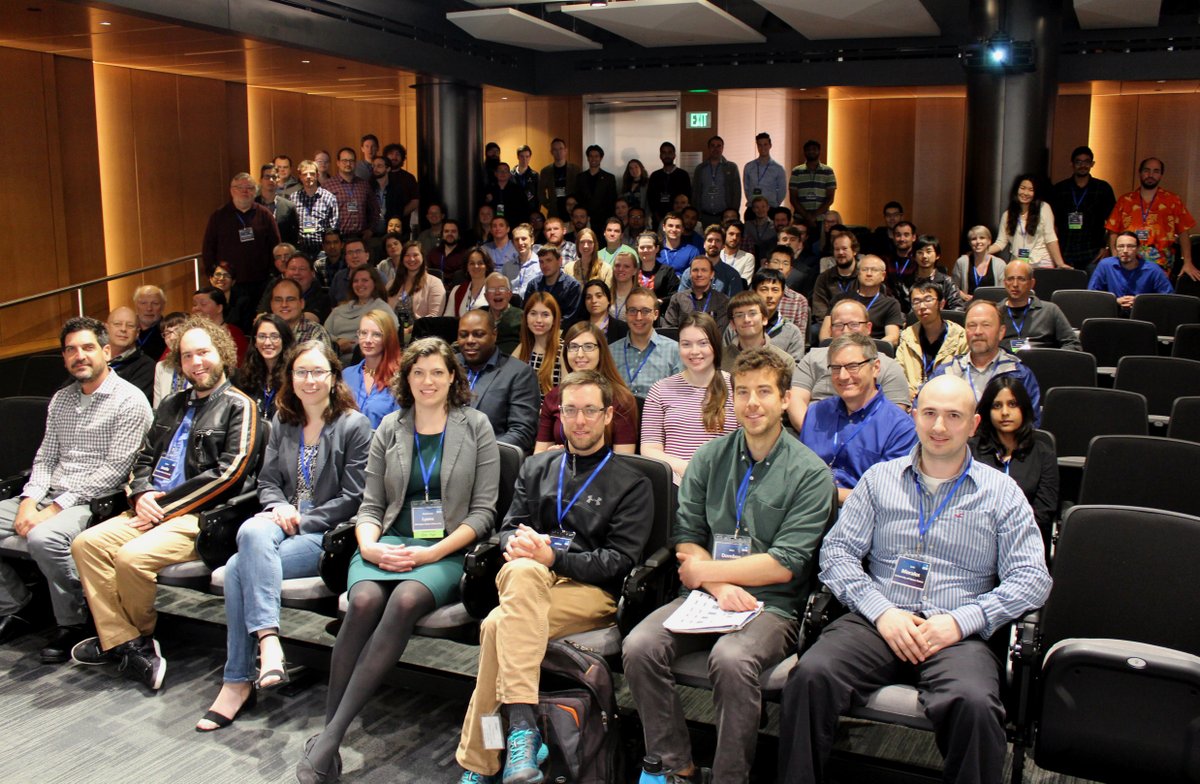 Russbach School on Nuclear Astrophysics 2019 in Austria: Mr. Yuta
Yamazaki (M1, The University
of Tokyo & NAOJ) attended the 16th Russbach School on Nuclear
Astrophysics and made an oral presentation on "Cosmic evolution of
r-process abundance pattern: Contribution from supernovae and neutron
star mergers".
The BUAA International Workshops on "HIAF & Astrophysics" and "Radii", Dec. 13-19, 2018: Two
international workshops on "HIAF High-Energy Beam Line Physics and
Nuclear Astrophysics" (Dec. 13-15, 2018) and "Proton and Neutron
Densities and Radii in Nuclei and Related Topics" (Dec. 17-19, 2018)
were held at Beihang University, Beijing in China, hosted by
International Research Center for Big-Bang Cosmology and Element
Genesis (IRCBBC) & International Research Center for Nuclei and
Particles in Cosmos (IRCNPC) at BUAA, and Institute of Modern Physics
(IMP), Chinese Academy of Science. GW170817/SSS17a was an event of the
century that has opened a new window to the frontier science of
multi-messenger astronomy and nuclear astrophysics. Incidentally the
HIAF project promoted by IMP/Lanzhou is approved and the construction
starts this year in Huizhou. Having this opportunity we discussed how
to promote interdisciplinary collaboration between HIAF science and
nuclear astrophysics.
COSNAP Group Activity in the fall of 2018 in Beijing:
Graduate students of COSNAP group at the University of Tokyo bring
themselves together at Beihang University in Beijing for carrying out
their research projects. Mr. Kanji Mori (D1, University of Tokyo) is
appointed a Research Associate of IRCBBC, Beihang University.

(Left) At the office of IRCBBC, Beihang University: Prof. Motohiko Kusakabe (BUAA), Mr. Hirokazu Sasaki, Mr. Kanji Mori, Mr. Yuta Yamazaki (University of Tokyo / NAOJ), Prof. Toshitaka Kajino (BUAA / NAOJ / University of Tokyo), Dr. Takehito Hayakawa (QST) (Right) Attending the neutron star workshop in Kavli Institute for Astronomy and Astrophysics, Peking University Mr. Yuta Yamazaki (University of Tokyo / NAOJ), Prof. Toshitaka Kajino (BUAA / NAOJ / University of Tokyo), Prof. Myung-Ki Cheoun (Soongsil University / BUAA), Mr. Kanji Mori (University of Tokyo / NAOJ) International Symposium of
Nuclear Science: Simplicity, Symmetry and Beauty:
International
Conference of Nuclear Science was held at Shanghai Jiao Tong
University, Sept. 26 - 28 2018, where Prof. Kajino gave an invited talk
on "Discovery of neutron star merger and supernova: Impact on element
genesis and neutrino physics". This conference was partly dedicated to
Prof. Akito Arima's 88th birthday celebration. Prof. Arima used to be
Prof. Kajino's supervisor, contributed greatly for promoting the honor
of the university as the President of The University of Tokyo, and
acted many new projects for the benefit of Japanese science and
technology as the first Minister of Education, Sports and Culture.
BUAA School of Physics Colloquia:
Prof.
Michael A. Famiano (Western Michigan University / NAOJ / BUAA), Prof.
Emiko Hiyama (Kyushu University / RIKEN) and Prof. Myung-Ki Cheoun
(Soongsil University / BUAA) gave colloquium talks at the School of
Physics, Beihang University on "Experimental Measurements and
Theoretical Predictions of Fundamental Nuclear Properties and
Astrophysical Nucleosynthesis", "Recent progress of hypernuclear
physics" and "Understanding of neutrino process in supernova explosion
and the roles of nuclear and neutrino physics", respectively, on Aug.
22, Sept. 14 and Sept. 17, 2018, hosted by IRCBBC, Beihang University.
2018 Two Summer Schools on
"Nuclear Astrophysics" in China:
Prof. Kajino
was invited as a lecturer to two Summer Schools on nuclear astrophysics
and gave several lectures on "Big-Bang cosmology", "Neutrino
astrophysics" and "Neutron star merger and supernova nucleosynthsis",
etc. The first Summer School on Nuclear Astrophysics was held in Hubei,
during August 1-7, 2018 and Profs. Marco Limongi (SNe), Mark Leising
(Type Ia supernovae and X-ray bursts), Gottfried Kanbach (gamma-ray
detection technology), Roland Diehl (cosmic radioactivity), Zigao Dai
(gamma-ray astronomy and neutron stars and mergers) also gave invited
lectures. The second 2018 Summer School on Frontiers in Nuclear
Astrophysics was held at Guiyang during July 30 - August 17, and many
physicists, astrophysicists and astronomers gave a variety of lectures.

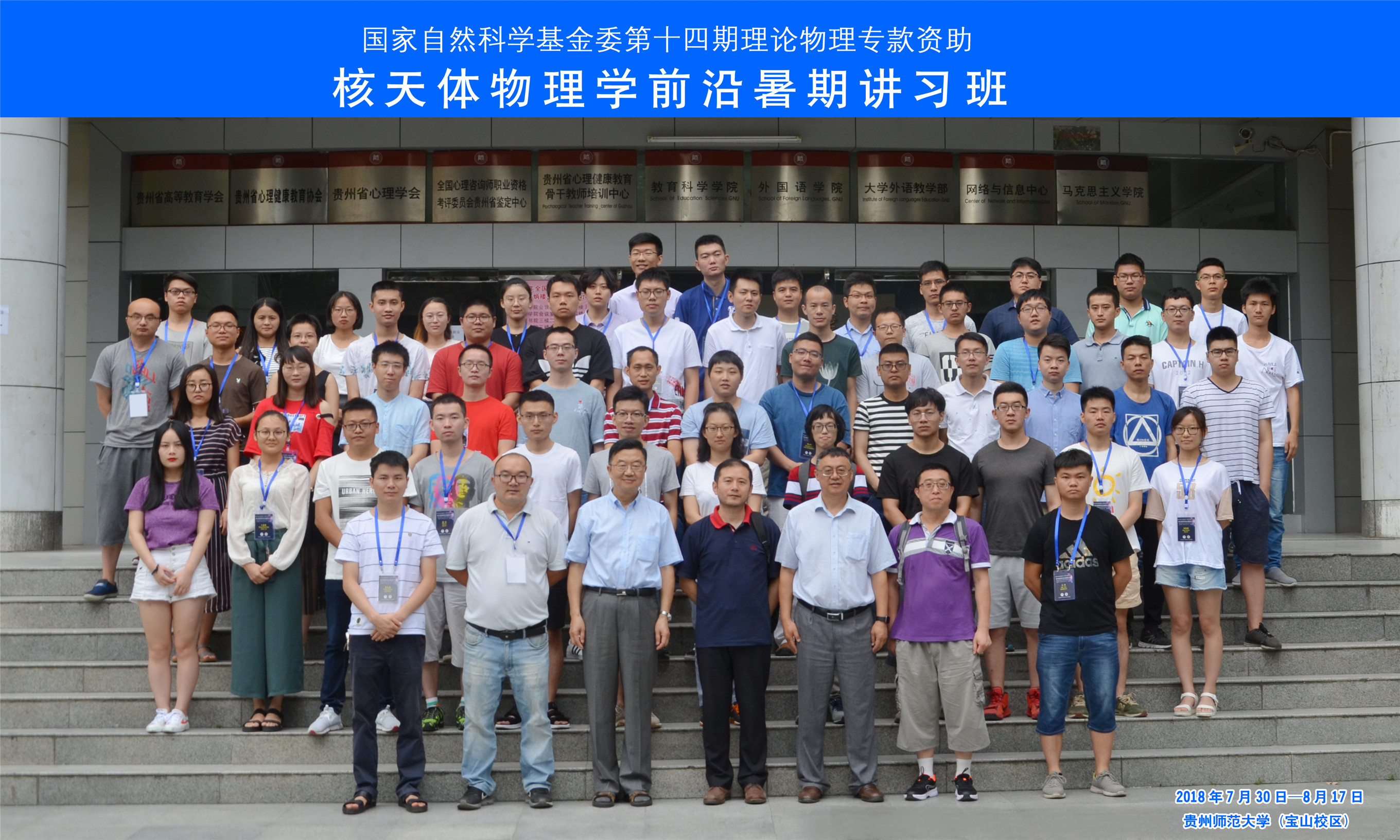 (Left) Lecturers at Hubei Summer School, August 1-7, 2018. (Right) Group photo at Guiyang Summer School, July 30 - August 17, 2018. 3rd RISP Intensive Program on
"Rare Isotope Physics" in Korea:
Prof.
Kusakabe (BUAA) and Prof. Kajino (NAOJ/UT/BUAA) were invited to
the 3rd RISP Intensive Program on “Rare Isotope Physics”, Daejeon,
Korea, July 4–7, 2018 and gave a series of lectures for junior
faculties, post docs and graduate students. Prof. Kusakabe's lectures
were on "Neutrino process nucleosynthesis in supernova explosions" and
"Origin of heavy elements and r-, s- and p-processes", and Prof.
Kajino's lectures were on "Galactic chemical evolution" and "Impact of
neutron star mergers and supernovae on nuclear physics and neutrino
physics".
"Nuclei in the Cosmos 2018" in
Gran Sasso, Italy:
The 15th
International Symposium on Nuclei in the Cosmos was held in Gran Sasso,
Italy, June 24-29, 2018. From COSNAP group Mr. Yudong Luo (M2, UT), Mr.
Kanji Mori (D1, UT), and Prof. Kajino (NAOJ/UT/BUAA) attended this
meeting and made presentations on "Inhomogeneous Primordial Magnetic
Field Strength and its Impact on Primordial Nucleosynthesis", "Impacts
of the New Carbon Fusion Cross Sections on Type Ia Supernovae", and
"Impact of neutrino collective oscillation on supernova nucleosynthesis
and mass hierarchy", respectively.
 Carpathian Summer School of
Physics 2018 in Romania:
Mr. Kanji Mori (D1, University of Tokyo) attended the Carpathian Summer School of Physics and made an oral presentation on "Quantum Mechanical Constraints on Resonances in Carbon Fusion Reaction and Its Impact on Type Ia Supernovae".  Symposium on Neutrinos and Dark
Matter in Nuclear Physics 2018, Daejeon, Korea:
The 6th
Symposium on Neutrinos and Dark Matter in Nuclear Physics was held in
Daejeon,
Korea, June 29 - July 4, 2018. From COSNAP group Prof. Cheoun, Myung-Ki
(Soongsil University), Prof. Balantekin, Baha (University of
Wisconsin),
Prof. He, Jianjun (National Astronomical Observatories, CAS), Prof.
Kusakabe, Motohiko (BUAA) and Mr. Sasaki, Hirokazu (UT) attended this
meeting and made presentations.
 Invited Lectures at GUPP at
Tohoku University:
Prof. Kajino
was invited to
lecture at the GUPP (Graduate Program on Physics for the Universe)
seminars at Tohoku University, Sendai, June 11-15, 2018. He gave a
series of lectures on Big-Bang cosmology and Element Genesis, entitled
"Big-Bang Cosmology and Primordial Nucleosynthesis", "Impact of neutron
star mergers and supernovae on nuclear physics and neutrino physics",
etc.
Workshop on Supernova
Nucleosynthesis at Kyushu University:
Prof. Kajino
(NAOJ/UT/BUAA),
Prof. Kusakabe (BUAA/NAOJ), Prof. Hayakawa (QST/NAOJ), Prof. Cheoun
(Soongsil University) visited Kyushu University and organized a
workshop on supernova nucleosynthesis during June 6-11, 2018. Prof.
Hashimoto (Kyushu University), Dr. Ono (RIKEN) and others as well as
four organizers gave talks on various aspects on evolution of massive
stars, supernova explosion, neutrino-nucleus interactions, neutrino
oscillations, etc. Prof. Kusakabe also gave a seminar talk on
"Primordial nucleosynthesis, Big-Bang lithium problem, Dark Matter, and
Galactic Chemical Evolution" at the Department of Physics, Kyushu
University.
Intensive Lectures on "Origin of
Elements and Life" at The University of Tokyo:
Visiting
Prof. Michael A. Famiano
(Western Michigan University/NAOJ) gave a series of intensive lectures
on "Elements in the Cosmos: from Fundamental Interactions to the Origin
of Life" at the Graduate School of Science, The University of Tokyo at
Hongo campus during May 16-18, 2018.
"Pioneer Symposium" in Korean
Physical Society Meeting in Daejeon, Korea:
Prof. Tomoya
Takiwaki (NAOJ),
Prof. Motohiko Kusakabe (BUAA/NAOJ) and Prof. Kajino (NAOJ/UT/BUAA)
were invited to the 2018 Spring Meeting of Korean Physical Society ,
Daejeon, April 25-27, 2018. They gave invited talks on "Recent progress
in supernova explosions", "Production of nuclei in Type II supernovae
via neutrino process", and "Impact of neutron star merger vs. supernova
on explosive nucleosynthesis and neutrino oscillation", respectively.
"Gravitational Waves and
Synthesis of Heavy Elements" in China:
Prof. Kajino
(NAOJ/UT/BUAA) was
invited to the 2018 Special Meeting on "Gravitational Waves and
Synthesis of Heavy Elements" held at Zhuhai, China, April 24-15, 2018.
He gave a special lecture on "Recent Progress in the Studies of
r-process Nucleosynthesis in Neutron-star Merger & Supernova:
Impact on Nuclear Physics".
"Intermediate-Energy Heavy Ion
Collisions" for Astrophysics in Tsinghua University, China:
Prof. Kajino
(NAOJ/UT/BUAA) was
invited to the 1st International Symposium on Intermediate-Energy Heavy
Ion Collisions, Tsinghua University, April 7-11, 2018. He gave an
invited talk on "Recent Progress in the Studies of Neutron-star Merger
& Supernova and their Impact on Nuclear Physics".
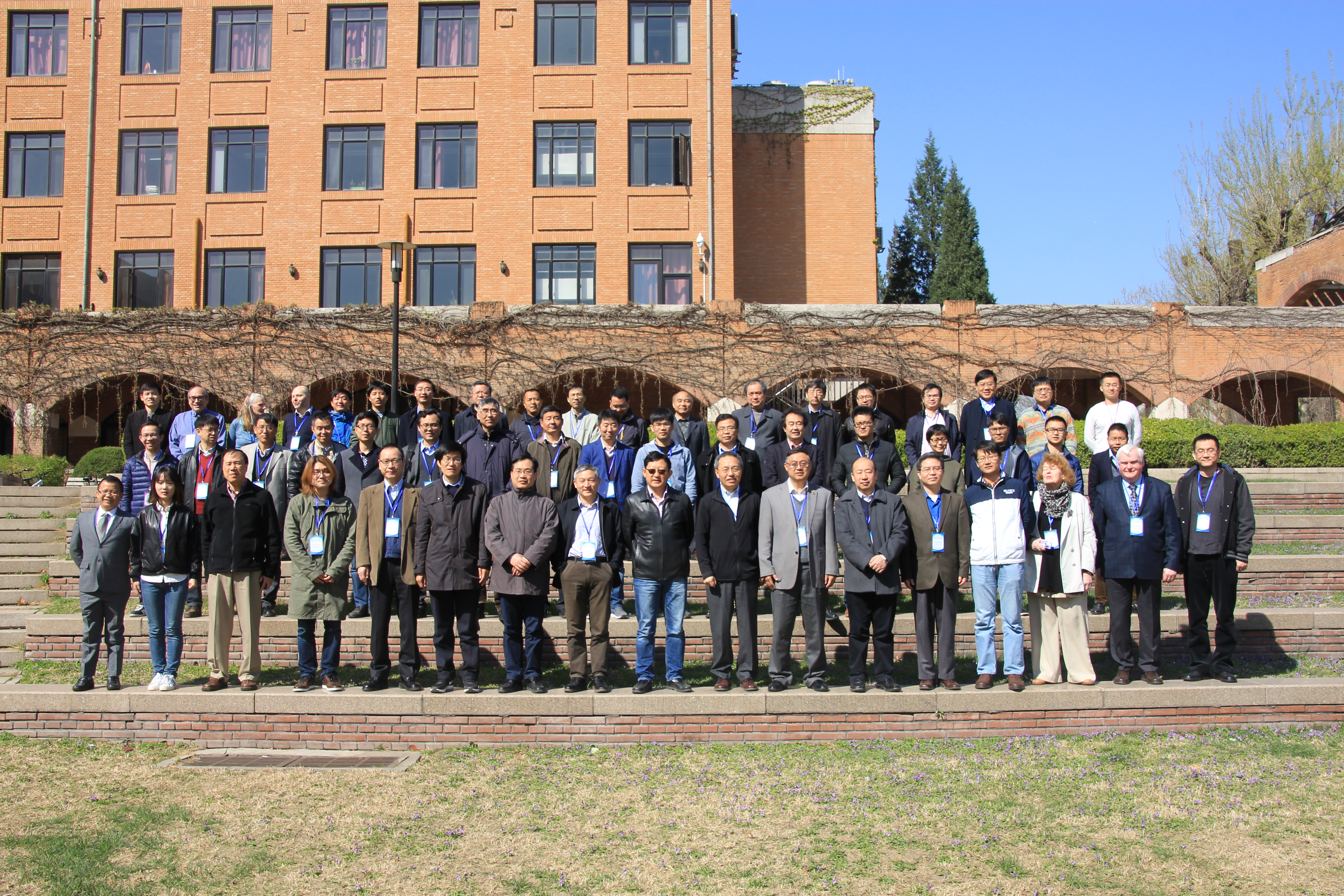 Nuclear Physics and Applications
in Eastern Asia in Shanghai, China:
Prof. Kajino
(NAOJ/UT/BUAA) was
invited to the 1st Workshop on Nuclear Shell Model Development and
Applications in Eastern Asia, held at T.D. Lee Institute at Shanghai
Jiao Ton University, March 30-31, 2018. He gave an invited talk on
"Quest for Nuclear Physics in Explosive Nucleosynthesis of Supernovae
and Neutron Star Mergers".
"Quantum Process and Element
Genesis" in Japanese Physical Society Meeting:
Prof. Kajino
(NAOJ/UT/BUAA) gave
an invited talk on "Supernova and Neutron Star Merger: Impact on
Explosive Nucleosynthesis and Neutrino Oscillation" in the Symposium on
"Quantum Processes in Celestial Environments and Element Genesis" at
2018 Spring Meeting of Japanese Physical Society.
|
||
| more |
||
| Toshitaka KAJINO website Division of Theoretical Astronomy, National Astronomical Observatory of Japan, and Graduate School of Science, University of Tokyo 2-21-1 Osawa, Mitaka, Tokyo, Japan 181-8588 TEL +81-422-34-3749, FAX +81-422-34-3746 Copyright (C) 2009- T. Kajino and Webmaster of TK website, all right reserved |
|
